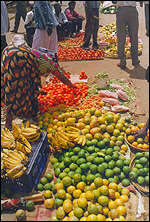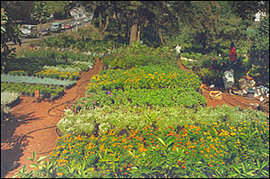 AGRICULTURE EMPLOYS 80% OF KENYANS AGRICULTURE EMPLOYS 80% OF KENYANS |

The development of geo or hydro sources of energy might prove more economic and cost efficient for the time being, but in the long run it might take its tall in the environment. In the past 20 years Kenya has severely suffered deforestation and soil erosion caused by natural disasters, such as extreme droughts and deluges, and by population growth and its immediate consequences: extensive use of wood as fuel and the clearance of forests for arable land. 2/3 of Kenya's surface is arid or semiarid, only apt for cattle. The former Minister of Agriculture, Hon. Mudavadi (present Minister of Information, Transport and Communication), would like to recuperate a substantial portion of those semiarid lands for agricultural purposes, rather than continue devastating woodland. "If we were to have irrigation in those areas, we could see a major shift in our overall agricultural production".
The agricultural sector and related activities account for 30% of Kenya's GDP, and it absorbs 80% of employment. It has recently surpassed the tourism sector as the major foreign currency earner. In fact, Kenya is today the largest exporter of tea in the world, having surpassed India, which has deviated much of its production for inner consumption. Kenya is one of the largest coffee producers in the international arena, occupying the 5th place in the flower exporting countries ranking. This has been achieved despite the liberalization of the economy that took place from 1992, opening the door to products from third countries at more competitive prices. Many of these countries were still subsidizing a number of commodities Kenya was opening up to. The market started to be dumped with cheaper goods. This considerably hurt the cotton industry. Oil seed was also hurt by direct competition from Malaysia. Brazil flooded the market with sugar at prices local farmers could not compete with. Other productions that also suffered were rice, wheat and barley. The government swiftly reacted by setting up strict duties to minimize the impact of these imports.
 ANYBODY FOR TEA? ANYBODY FOR TEA? |
El Niño rains have had varying effects depending on the products. The pineapple plantation Del Monte has in Thika, was washed away by the floods. Replanting could not be performed due to bad weather conditions. Consequently their production for 1999 has gone down approximately 40%. On the other hand, the rains boosted the production of maize, wheat, sugar cane and tea, products that thrive under high humidity conditions.

The tea industry is one of the best organized in
the sector. However there have mounting criticisms
from within the sector about their regulatory bodies.
Kenya Tea Development Authority's Managing Director
was discharged by Dr. Leaky as one of his first
measures to stop mismanagement and corruption in
the country. Kenya's total production of tea oscillates
between 300 and 250 Th tons per year. Brook Bond
Kenya Ltd. is the largest producer of tea in Kenya.
Their production amounts to 12-13% of the Kenyan
total production, according to Mr. Julian Stanning,
MD. The reason for their size might be explained
by the fact that the company was originally a parastatal.
When it became public in 1972, 88% of its shares
were purchased by Brooke Bond Group - Unilever.
They are big providers of employment: 18.000 people.
95% of their production is exported to international
markets, particularly the UK, Middle East, Egypt
- which seems to have an insatiable appetite for
Kenyan tea - and even Pakistan. |
Due to its altitude (Nairobi is 1, 600 m high) and benign climate, Kenya is able to grow tea all year round, whereas in most countries production is seasonal. Being the largest producer in the region and strategically located by the sea, Kenya became the international tea center for the region. Mombasa, having the largest port in the area, became the natural exit for the neighboring tea-producer countries, which now send their tea to be auctioned in the Mombasa International Tea Auction. Today the city of Mombasa has become the second largest tea auction center in the world, after Colombo (Sri Lanka).
 COFFEE AND FLOWERS COFFEE AND FLOWERS |

Coffee is an altogether different story. Kenya has always specialized in high grade, high quality Arabiga variety of coffee. Kenya's coffee is mostly used for blending in the USA and Europe, explains Mr. Wamai, from Wamai Coffee. For some time there was an international shortage of this type of coffee, so Kenya benefited from this. But soon new players such as Brazil or Vietnam saw the possibilities and profitability of the Arabiga variety and soon came into the market. This has seriously affected Kenya, since the prices have sled down in the past few years, and it seems they will continue that trend. The only thing that can help the sector is a weaker Kenyan Shilling. "Overall the prospects for coffee are not quite so good as those for tea because of worldwide competition", summarizes Mr. Paul Thomson, Resident Representative of East African Conference Lines. The rampant corruption existing in the Coffee Board of Kenya did not help much either. Until the dismissal of its Managing Director late September 1999, there were constant complaints by coffee farmers in the local press denouncing the abusive behavior of the board. The highest yield of coffee ever produced by Kenya has been 2 million bags (60 Kg each). Brazil will put out 34 million bags in the market in 1999. Thus competition is impossible, especially since Kenya coffee is sold in bulk to be later blended. But as Mr. Wamai put it "we should be able to create an environment that would encourage anybody involved in the industry to add value to our product by exporting finished, roasted, packaged coffee".

The new star in the Agricultural sector is horticulture, particularly flowers. There are 1,600 Has. of flowers cultivated the country. The annual growth rate is 20%. In 1997 el Niño rains caused the loss of about 6,000 tons of flowers, consequently reducing the amount of exports to 30,000 tons, instead of the expected 36,000 tons. In 1999 they expect to reach that figure since production for the 1st quarter of 1999 was excellent, explains Kenya Flower Council's Managing Director, Mr.Michael Morland. This private association created a code of practice in order to deal with some of the problems of this mostly unregulated industry. Recently Kenya was denounced for the use child labor in the flower plantations. According to Mr. Morland, their inner code does not allow children below 16 to work in the states of their members. If children were used it would seriously affect their exports since most of the production is destined to foreign markets. 95% of the output goes to Europe - Holland auctions - South Africa and Australia. As in the case of tea, Kenya's climatic conditions allow cultivation all year round. Another competitive advantage is its cheap labor (70% of the workers are women), and the government suppression of taxes on horticultural products such as greenhouses, etc. |

